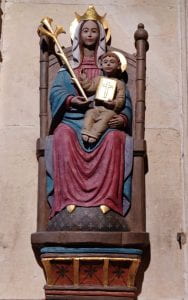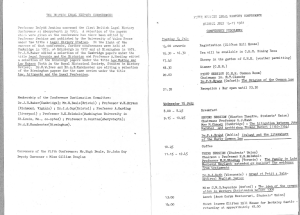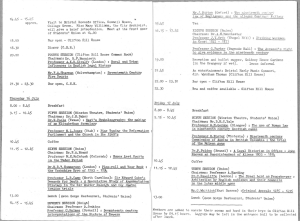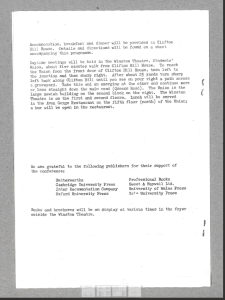
A recent article in The Guardian, dealing with a current criminal case in France, happened to mention a piece of research I did some years ago. It is always interesting to see one’s work ‘out there’ in the world, having something of a life of its own and reaching a more general audience, and to take in, and react to, other people’s views of it. Given the particular context of the current case with which it has been linked, it would have been inappropriate to express immediate ‘delight’ on social media at having been noticed in this way, but setting out a few thoughts on the matter, in a blog post, seemed to be in order.
The research
The work referred to was published in an article in 2017 (Drugs, deceit and damage in thirteenth century Herefordshire: new perspectives on medieval surgery, sex and the law. Social History of Medicine, 30(2), 255-276). This was a discussion of a case I found in a thirteenth century legal record, the significance of which had previously been overlooked.
Briefly, when looking in two rolls of legal proceedings of a royal court sitting in Herefordshire in 1292, I came across the case of Isabella Plomet and Ralph de Worgan. The records showed that Isabella had complained that she had sought Ralph’s medical help with a problem she had with her leg, and he had agreed to treat her, he had given her an anaesthetic draught, but then proceeded to force himself upon her, and ‘lay with her against her will’. They also made it clear that a jury (and an all-male jury at that) found in Isabella’s favour. Ralph was ordered to compensate her to the tune of one mark (thirteen shillings and four pence) and was also obliged to pay a fine to the king. Steps were taken to ensure that he left Isabella alone thereafter.
At the time I first came across Plomet, I was most struck by the ‘history of medicine’ aspect of the case: dwoledreng, the anaesthetic mentioned in the report was, intriguingly, in a different language from the rest of the report – an English word amidst the usual Latin. That switching of language said some interesting things about knowledge of drugs in medieval society, as well as sending me off to the literature on this particular concoction. That this aspect struck me as the most likely to be of interest to others can be seen from my choice to send my work on Plomet to a history of medicine journal. It has, however, probably attracted greater attention for the connections it seems to have had in people’s minds with the still-hugely-problematic area of rape law.
The case has become reasonably well-known amongst those who work on medieval women and gender, and naturally, since no historian is cut off from the concerns of the period in which she is living, people have thought about it in connection with those modern concerns. One leading scholar who has commented on it, both in her academic work and in her more public-facing writing, has been Professor Carissa Harris, a medieval literature specialist. As well as considering it in her work about literary portrayals of sexual misbehaviour, Harris linked it to discussion of another famous ‘drug-faciliatated rape’ case of a few years ago: that of Bill Cosby.
The context in which Isabella Plomet and her 1292 case have been raised recently is that of the Pélicot case. This is a (currently on-going) trial centring on the rape and sexual abuse of a woman, Gisèle Pélicot. Over an extended period, by his own admission, her then-husband, Dominique Pélicot, raped her and invited other men to penetrate her when unconscious, after he had drugged her with Lorazepam. Most of the men in question pleaded not guilty to rape, though not in the sense that they alleged that Mme Pélicot consented to the penetration. Rather, relying on the French penal code’s definition of rape, some of them argued (essentially) that they were not aware that the penetration was against her will, but thought that it was all part of a sex game in which she was, in some sense, a willing participant. The relevant French provision does not focus on the lack of consent as the core of the offence, but identifies penetration ‘by violence, constraint, threat or surprise’, as the requirements for a conviction. There has been the strong suggestion that it should be altered, to bring in absence of consent more explicitly, and the line of defence used in this case has intensified discussion of the desirability of making this change.
There are some clear similarities between ‘my’ thirteenth century English case and this twenty-first century French one: use of drugs, sexual penetration without consent or against the will of the woman, deception/abuse of a position of trust. There are also differences. In terms of the factual elements of the cases, the ‘medical’ context in Plomet is absent from Pélicot and the spousal relationship at the centre of Pélicot is not present in Plomet; the multiple attacks in Pélicot are not alleged in Plomet; the outcome in Plomet is financial, while that in Pélicot will be sentences of imprisonment for those who have pleaded guilty or been convicted.
It is the use of drugs to facilitate sexual penetration which is not wanted by the woman which is to the fore in Anna Moore’s Guardian article. This makes the point that there is a long history of such misconduct. One might make a closer link, and note the continuity in the misuse, more specifically, of ‘medical’ drugs (as opposed to alcohol or ‘recreational’ drugs) for this purpose. Lorazepam and dwoledreng could both be used for legitimate medical purposes, as well as the nefarious purposes to which they were put. Another interesting facet of the connection between the two lies in the way in which they show new scientific or technological developments paving the way for new techniques of victimisation. Ralph de Worgan used his privileged medical role and his knowledge of drugs, to get access to Isabella Plomet and rape her; Dominique Pélicot admitted to having used modern anti-anxiety medication and the internet to accomplish his ends.
Another point of connection may lie in the role of the complainant. Gisèle Pélicot has received widespread praise for her unusual bravery, in speaking out on the crimes against her, and in waiving anonymity in the pursuit of justice for herself and the hope of improvement for others. Her image and character have become well-known. We cannot know anything like as much about Isabella Plomet, and how she ended up in court, complaining about her mistreatment, but, given contemporary gender ideas and the vanishingly small number of rape cases which did not end with abandonment or acquittal, this is likely to have taken considerable courage, and Isabella Plomet’s case was also unusual in the procedure used. Plomet was not a straightforward equivalent of a modern rape prosecution. The rough equivalent in the medieval period was an appeal of rape, i.e. an individually-brought prosecution. Isabella Plomet took a different approach, using the plaint procedure. We might see this as something a little more like a tort action than a criminal prosecution, though the comparison is not exact. What is important is that this would not result in such a serious penalty as was theoretically the expected outcome in an appeal of rape (capital punishment plus property forfeiture) but it was more flexible in terms of how the case could be put, and this was important in Isabella’s case. Her problem was that she had apparently gone along with some of Ralph’s treatment (going with him from Hereford to Ross on Wye, drinking the draught he provided her) which might well have meant that an appeal of rape would be unsuccessful. Using the plaint procedure meant that Isabella could express the wrong done to her in different terms to those required in an appeal. Discussions of the appeal of rape in medieval legal treatises suggest the need or expectation for a demonstration that the penetration was against the woman’s will, by means of exhibition of torn clothes and physical injury. While modern French law clearly does not require that, the Pélicot case is drawing attention to the particular problem of a legal definition of rape which arguably allows defendants to say that they thought it was acceptable to penetrate an unconscious woman without her clear consent.
In addition to greater freedom to formulate the accusation under the plaint procedure, it may well also have been the case that the prospect of some financial compensation from a successful plaint was rather more useful an outcome to Isabella Plomet than she would have found the execution of Ralph, in theory the outcome of an appeal of rape. The compensation she managed to secure (one mark) was not a mere token: the trusty time-travelling currency converter from the UK National Archives gives an indication of scale, suggesting that, in the 1290s, one mark was around the price of a cow, or 66 days’ wages for a skilled tradesman. That may well have been enough to make a difference to a survivor’s life and prospects (as well as hurting the convicted offender).
In years since I published my article, I have continued to think about the Plomet case, and have discussed it (with, I hope, all due caution and sensitivity) with my Legal History students. My thinking has often been aided or prompted by the ways in which others have regarded the case: as with all historical study, re-examination, addition, revision and nuancing is healthy and necessary. The latest use of the case, and the conversations I have had as a result, will no doubt inch my thinking on once more. I think that I will probably now always wonder whether Isabella Plomet had some character traits in common with Gisèle Pélicot. That is, I think, a normal human reaction: our minds respond to striking stories with strong characters. At the same time, there may be a danger in concentrating too much on such exceptional cases. Isabella Plomet’s case stood out to me, and I highlighted it in my research, because it was so unusual. The Pelicot case has attracted widespread press attention because of its extreme and unusual facts. Both are fascinating, but neither should be pushed too far. It is attractive to see the exceptional ‘win’, to cheer at signs of special bravery, persistence or ingenuity on the part of those who have been subjected to sexual offences, to be heartened at demonstrations of solidarity with the victim as she puts herself through the ordeal of a court case. Nevertheless, it does need to be borne in mind that the vast majority of cases of sexual violence do not receive this level of interest or support, and that no legal system has yet been designed or operated so as to give justice in the less spectacular, less intellectually engaging, less potentially the subject of ‘REF-able’ articles, but vastly more numerous, body of rape cases which occur every and in every jurisdiction.
Gwen Seabourne
3/12/2024
Notes:
The Plomet entry can be seen here, courtesy of the peerless Anglo-American Legal Tradition website: (JUST 1/302 (Rex Roll) m. 76; JUST 1/303 (Berwick’s Roll) m. 75 is very similar).
For an English-language overview of the issue of consent in French rape law, see, e.g., S. Lannier, ‘Including or excluding consent to the French offence of rape: an analysis of the criminal literature’, Int J Semiot Law 37 (2024), 2465–2487.












